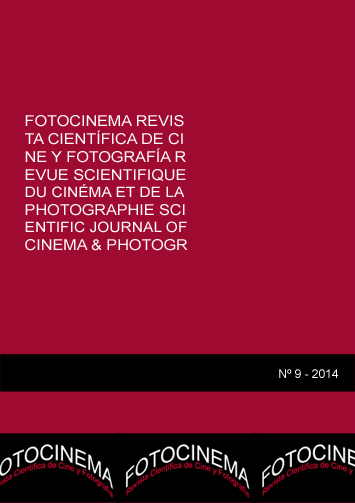Theo Angelopoulos, paisaje, hombre. Entre la tragedia griega de la historia y la desgracia de los hombres
DOI:
https://doi.org/10.24310/Fotocinema.2014.v0i9.5971Abstract
La Historia griega y la herencia cultural mítica y rural recorren la filmografía de Theo Angelopoulos en obras donde el viaje marca la estructura principal de sus películas a través de la figura de un hombre/personaje. El presente análisis pretende desentramar la moral que le mueve, ya sea existencial o de cualquier otro tipo, así como investigar la naturaleza de su desgracia y el motivo de ésta, fijándose en el papel que adquiere el hombre y de qué manera influyen en él elementos como la Historia, el paisaje y el destino, así como la forma en la que se relacionan entre sí a lo largo del viaje.Abstract:
Greek History, mythical culture and rural culture are all present in Theo Angelopoulos’ filmography, in which the journey marks the main structure of his films through the figure of a man/ character. This analysis seeks to unravel the moral that move him, either existential or any other kind, as well as researches the nature of his misfortune and the reason of it, focusing on the role that man takes on and how it affects in him through various elements, such as History, landscape and destiny. Furthermore it examines how each of the elements relates to each other along the journey.
Palabras clave:
Theo Angelopoulos; cine griego; tragedia griega; paisaje; análisis fílmico.
Keywords:
Theo Angelopoulos; Greek cinema; Greek tragedy; Landscape; Film Analysis.
Downloads
Metrics
Publication Facts
Reviewer profiles N/A
Author statements
Indexed in
-
—
- Academic society
- N/A
- Publisher
- Universidad de Málaga
Downloads
Published
How to Cite
Issue
Section
License
All contents published in Fotocinema Revista científica de cine y fotografía are protected under the Creative Commons Attribution-NonCommercial-ShareAlike 4.0 International (CC BY-NC-SA 4.0) license. All about this license is available in the following link: <http://creativecommons.org/licenses/by-nc-sa/4.0>
Users can copy, use, redistribute, share and exhibit publicly as long as:
- The original source and authorship of the material are cited (Journal, Publisher and URL of the work).
- It is not used for comercial purposes.
- The existence of the license and its especifications are mentioned.
There are two sets of authors’ rights: moral and property rights. Moral rights are perpetual prerogatives, unrenounceable, not-transferable, unalienable, imprescriptible and inembargable. According to authors’ rights legislation, Fotocinema. Revista científica de cine y fotografía recognizes and respects authors moral rights, as well as the ownership of property rights, which will be transferred to University of Malaga in open access. The property rights are referred to the benefits that are gained by the use or the dissemination of works. Fotocinema. Revista científica de cine y fotografía is published in an open access form and it is exclusively licenced by any means for doing or authorising distribution, dissemination, reproduction, , adaptation, translation or arrangement of works.
Authors are responsable for obtaining the necessary permission to use copyrighted images.














13.png)



